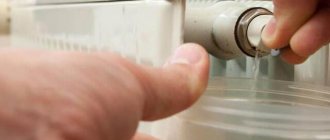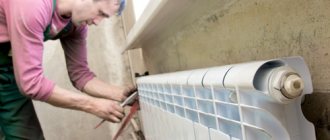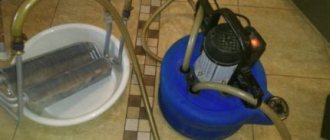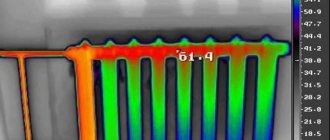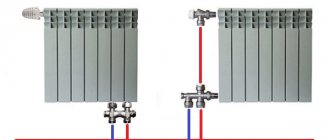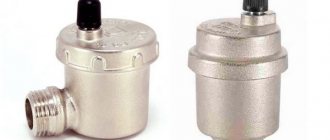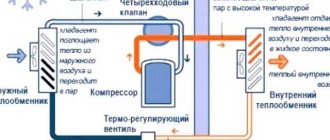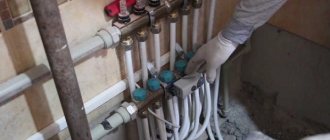How to bleed air from a heating battery using a Mayevsky tap
Depending on the heating design, the Mayevsky tap is installed in places where air can accumulate and create an obstacle to the flow of water. When filling the heating system with a new portion of coolant or during operation, air should be vented if necessary. To do this you need:
- Prepare any container of 2 liters or more, or a rag, sponge, anything that absorbs water. Place them directly under the outlet of the Mayevsky tap.
- Open the tap so that you can hear the hissing of the escaping air.
- Once all the air has come out and only water comes out, close the tap.
A common mistake encountered in practice is that gradually, when air is released, the coolant begins to be sucked in, and it comes out in portions. However, this does not mean that it is time to turn off the tap. It is possible to determine that there is no air left only if the water comes out evenly and without splashes. A container or rag will help deal with just that small amount of water before you can turn off the tap.
It is necessary to repeat the procedure for bleeding air at all points where the Mayevsky valve is installed. In houses with two or more floors, air descends first from the lower radiators, and then from the upper ones.
Air bubbles contained in the coolant tend to accumulate in certain places in the heating network and inside radiators. The resulting bubble continues to be fed with new portions of oxygen and develops into an air plug, blocking the movement of heated water in this area. As a result, nearby batteries or radiator sections cool down.
To bleed air from the heating system, 2 types of valves are used:
- Mayevsky manual crane;
- automatic air vent of float type.
The design of the Mayevsky valve shown in the drawing is not difficult to understand. At the end of the brass body with an external threaded connection ½” (DN 15) or ¾” (DN 20), a hole Ø2 mm is made, the cross-section of which covers a screw with a conical tip. There is a small diameter hole made in the side of the body, designed to release air.
Sectional drawing of a Mayevsky screw crane
The mechanical “air vent” works as follows:
- In heating operation mode, the shut-off screw is tightened and the cone seals the hole.
- When you need to release the air lock, the screw is unscrewed 1-2 turns. Under coolant pressure, air passes through a hole with a diameter of 2 mm, enters the outlet channel and moves outward along it.
- First, clean air escapes from the hole, then mixed with water. The screw is tightened after a dense stream of coolant flows out of the channel.
Varieties of valves according to the method of unscrewing
The Mayevsky air valve with a manual drive is a trouble-free means for releasing gases from pipelines and heating radiators. The secret of reliability is the absence of moving parts that can become clogged, worn out or rusted. As a rule, the valve is used as a radiator air vent.
Manual heating air valves are divided into types according to the method of unscrewing the screw:
- using a plastic or metal handle;
- the traditional option is a slot for a flat-head screwdriver;
- square head screw to use a special wrench.
It is easy to guess that this type of air release valve operates without human intervention. The element is a vertical barrel made of brass with a threaded connection G ½ “(DN 15), where a plastic float is placed. The latter is connected by a lever to a spring-loaded air release valve mounted in the lid.
The operating principle of the automatic air vent is as follows:
- In operating mode, the chamber inside the housing is filled with water, pressing the float upward. The spring loaded air valve is closed.
- As air accumulates in the upper zone of the chamber, the coolant level decreases and the float begins to descend.
- When the level drops to a critical value, the weight of the float overcomes the elasticity of the spring and the valve opens, bleeding air outward.
- Due to excess pressure in the heating system, water will displace all the air from the chamber of the device, take its place and raise the float again. The valve will close.
When the pipeline network is filled with coolant, air removal occurs continuously while the float lies at the bottom of the tank. As soon as water fills the chamber, the spring will close the valve and bleeding will stop. Please note that part of the air mixture will remain inside the housing under the lid itself, which will not affect the normal operation of the heating.
According to their design, automatic air vents come with straight and angular connections. Some manufacturers discharge the discharge vertically upward, others - to the side, from the side “spout” with a jet. From the point of view of the average homeowner, these differences do not matter much, but they will tell a master plumber a lot.
The design of automatic air vents is constantly being improved. Leading manufacturers of heating system parts provide their products with additional functions:
- Protection against water hammer using a reflective plate (placed at the entrance to the chamber).
- Effective capture of small bubbles is achieved in a flow-through design with two horizontal fittings for connection to the network. The lower zone of the increased volume of the tank is occupied by a special filler, which stops moving air bubbles and collects them in the chamber. Once you unscrew the element from the adapter, the spring will close the passage with a plate
- Possibility to remove the air vent for maintenance purposes without emptying the pipes. This is achieved by installing an automatic shut-off valve with a spring on the inlet fitting. When the plumber unscrews the element, the spring straightens and the washer with the O-ring seals the passage, as shown in the diagram above.
- Embedding a mini-valve into the radiator plug (see photo). Air valves designed as radiator plugs
In any water heating system there are places where the installation of air vents is mandatory. If we talk about Mayevsky’s taps, then they need to be installed on all batteries in order to bleed off the collected air. The exact location is in the plug of the upper corner, distant from the point of connection of the supply line to the device. An air bubble forms there.
If the boiler is equipped with a built-in air vent, then there is no need to install it on the supply
The automatic air valve must be installed strictly vertically at the following points in the heating network:
- in the safety group of a boiler connected to a closed type system;
- on both underfloor heating collectors;
- if the highest point is a pipeline and not a radiator, then a float air vent cuts into it;
- into a buffer tank and an indirect heating boiler, if provided for by the design;
- on the heated towel rail coil;
- into the common distribution comb of a complex and branched system (to both collectors);
- to the hydraulic circuit separator (hydraulic arrow).
- Direct the hole on the faucet body into a basin or other prepared container. It is important to bring the container as close to the tap as possible to avoid splashes on the walls and floor.
- Using a special key for the Mayevsky tap or a flat-head screwdriver, start unscrewing the locking screw on the valve body counterclockwise. Important: turn the key very smoothly
- Air will begin to escape with a hissing sound and a characteristic sound.
- Keep the tap open until all the air has escaped and water flows out in a continuous thin stream.
- Smoothly close the tap clockwise with the key.
Bleeding air without a Mayevsky crane
Most home heating radiators have a special device that helps simplify the task of bleeding air as much as possible - a Mayevsky tap or an automatic valve.
But the question is: what to do if there is simply no such device on the battery? If this is exactly the picture that appears before your eyes, most likely, cast iron batteries are installed in your house. Such batteries are often fitted with a simple plug, which is screwed onto a tow coated with paint. In addition, it was also covered with a layer of paint while painting the heating radiators.
Mayevsky crane
It seems difficult to remove it in order to gain access to the coolant located in the system. For this reason, the simplest way out of the situation is to contact your neighbors from the top floor of the house (they will probably have a Mayevsky tap on the radiator). But if the neighbors, for example, have left or you yourself are a resident of the top floor and there is no tap? In this case, you will have to resort to the “old-fashioned” method of bleeding air from the heating system.
So, you need to stock up on a basin, a bucket and plenty of rags. In addition (you can’t take this “barrier” with your bare hands), you will need an adjustable wrench to unscrew the plug and some kind of paint solvent. Otherwise, you simply will not be able to move the plug from the “dead” point.
So, first apply solvent to the place where the plug is installed and wait about 15 minutes. After this, carefully start moving the adjustable wrench along the thread until the plug begins to feed. You will hear the air begin to bleed. When the sound subsides (a sign of lack of air), be sure to wrap a layer of foam around the plug and insert it into place. If desired, you can lightly paint over the junction of the plug and the battery.
Advice. Before starting work, it is advisable to shut off the riser for work safety, otherwise with a sufficiently sharp jerk you will completely unscrew the plug and the water from the battery will no longer be stopped.
You learned how quickly and quite simply you can cope with the task of bleeding air from a heating radiator in the absence of a Mayevsky tap. Good luck!
Key for Mayevsky crane
Content
To use manual models of equipment, a special key or valve is required. It comes complete with the mechanism itself and most have a typical design with a rectangular cross-section. When the valve is turned, the valve begins to bleed air from the system. However, it is not uncommon for the key to be lost or left with the previous owners of the premises, and the new owners do not know how to open the Mayevsky tap. In this case, in any hardware and specialty store you can purchase a standard key suitable for most models from:
- durable polymer;
- metal
How to install a Mayevsky crane
Installation of the Mayevsky crane is quite simple and does not require special skills.
- Drain the system. If the heating network is equipped with a pump, turn it off 15 minutes before starting work.
- Unscrew the plugs in the places where the valves will be installed. Usually this is the top point of the radiator, farthest from the heating device; it is in such places that air most often accumulates.
- Screw in the Mayevsky tap so that the outlet is directed away from the wall at 45 degrees downwards - for easy collection of water when opening the valve. To ensure a tight seal, it is recommended to wrap the threads with oiled tow or FUM tape.
Installation features in certain situations
The easiest way to install a Mayevsky tap is in modern radiators, where all the necessary holes are provided.
When installing the tap on different types of pipes and types of heating circuits, you need to consider the following:
- In a vertical thermal circuit, the device is mounted in radiators on the top floor and on devices connected to the riser below the heating axis.
- In a horizontal heating system, taps are placed on all devices where this is structurally possible.
- In a floor radiator, the highest point is selected for installation, and the tap is placed with the screw facing up.
- In a heated towel rail with a bottom connection, the place for installing a tap is provided by the manufacturer. A tee is first cut into a heated towel rail with a side connection, and an air vent is installed into it. It is better to equip a heated towel rail with a complex shape with several valves.
- Cast iron batteries may not have a suitable hole; preparatory work will have to be done. You need to cut a hole in the plug slightly smaller than the size of the tap thread, cut the thread and then screw in the valve, further insulating the mounting location.
Note! To simplify working with a cast iron battery, it is better to completely disconnect it and select an air vent with a minimum external thread diameter.
How to properly bleed air from a battery
But if this is the only option for bleeding air from the system, then prepare an adjustable wrench, sandpaper, solvent and a basin, and also cover the surface near the battery with rags or rags.
- Sand the connection area of the plug with sandpaper.
- Apply a small amount of solvent to the joint, after 10-20 minutes, clean off the loose paint layer with a sharp object
- Next, use an adjustable wrench counterclockwise to unscrew the plug.
- If everything is done correctly, you will hear the characteristic sound of air being released.
- As the sound fades, water will begin to ooze from the connection, this is where a basin and rags will come in handy.
- Once the sound stops, screw the plug back in clockwise.
- For greater reliability, you can paint over the connection a little.
Airing is easy to detect during heating operation
It is important to know that air is generated inside the system even when it is not operating. Many people do not pay attention to this nuance, but in vain. Oxygen inside the battery and metal pipes promotes corrosion. Pieces of rust fall off and clogs form. To extend the life of the system, the air in the heating radiators in the apartment is bleed even in summer.
During this period, airing most often occurs for the following reasons:
- The summer period is reserved for heating repairs. Plumbers from a service organization change valves and rotten pipes. To repair a separate area, water is drained from the entire riser.
- In the summer, apartment owners independently repair their heating. Due to the inability to disconnect the circuit from the centralized system, water is similarly discharged from the entire riser. In some cases, they drain from the entire multi-story building.
- If the shut-off valves at the entrance to an apartment building were closed, according to the laws of physics, the volume of coolant decreased. After opening the valves, water supplied under pressure sucks in air and fills the risers with it.
- Often in the summer, mechanics deliberately relieve pressure from risers in order to avoid unnecessary work in the future. The fact is that old cast-iron batteries, after stopping the heating, sometimes begin to leak at the junctions of the sections if they stand for a long time under high pressure of the cold coolant. It is easier for mechanics to relieve pressure than to change many gaskets while performing complex disassembly of sections.
Installing a tap prevents water from being used for other purposes
How to bleed air from a radiator if there is no Mayevsky tap
If you don’t have a Mayevsky tap, then you have old-style batteries and a regular plug is installed instead. As a rule, it is covered with a layer of paint, so unscrewing it will not be easy.
To work you will need:
- Rags or rags;
- Gas key;
- Container for draining water;
- Solvent or rust converter;
- Fum tape.
Let's get started:
To begin, place a bucket under the section with the plug. Wrap part of the battery around the plug with a rag - it will prevent high water pressure.
Spray the plug-battery joints generously with solvent or converter. Try unscrewing the plug with a gas wrench. Do not use excessive force to avoid stripping the threads.
If the plug does not budge, use solvent again. When it starts to unscrew, turn it carefully. It is advisable not to take it out completely - otherwise a large stream of water will rush out.
Advice
Install an automatic gas vent instead of the plug. It will periodically bleed the accumulated air and you will no longer wonder how to bleed the air from the heating battery.
The photo shows that in this case the plug has a left-hand thread.
The thread can be left or right. Therefore, try unscrewing the plug in both directions.
As you turn the plug, listen to see if air has escaped. Place your hand to feel the flow. When the air is completely released, wait until 3-5 liters of water flow out of the battery.
Before installing the plug, wrap it in 1-2 layers of fum tape. Do this against the direction of the thread - this will ensure a better seal. Screw the plug as tightly as possible.
Advice
If you decide to paint the end cap or the entire battery, be careful not to get any paint on the joint.
Design and principle of operation
The design and principle of operation are almost completely described in the official name of the Mayevsky crane. This is a needle valve with a cone-shaped rod that closes the through channel in the device. Inside the valve there is a thin hole for bleeding air, which opens only if you start to unscrew the stem.
To open the air vent, you will need a special key or a regular slotted (flat-head) screwdriver. After completing a half or full rotation, a thin channel opens between the contents of the radiator or pipe and the external environment. Due to the high pressure inside the heating system, air and coolant are released outside, and not backwards. If air has accumulated at the installation site, it will come out first, followed by water.
The Mayevsky tap is made of corrosion-resistant brass, which ensures a long service life. Most often this is a plug made with a ½ or ¾ inch external thread, equipped with a needle valve.
Automatic crane operating diagram
The Mayevsky valve is a shut-off control valve that performs the functions of an air vent in heating devices. In its manufacture, brass is most often used. A faucet is a device with a hole for air outlet and a screw screwed into it. To ensure the tightness of the faucet when installed in a heating system, a special sealing ring is put on it.
The valve is controlled manually using an adjusting screw. Adjustment can be made with ordinary screwdrivers or a special wrench.
In addition to the simple name, there is also a more complex one - radiator needle air valve. The faucet is usually installed on radiators in plugs with special threaded holes. Or it can be installed at the highest points of the heating system.
There are two types of Mayevsky valve: manual and automatic.
What is a Mayevsky crane?
Attempts to solve the problem of air locks in heating systems were made at the beginning of the 20th century. For this purpose, taps were actively used - they coped with the task of bleeding air, but they were often used not only for their intended purpose, but also to drain water from the heating circuit for other purposes.
Uncontrolled coolant discharge caused damage to the heating network, as it could cause the formation of additional air pockets and changes in pressure in the pipes. In addition, due to the high temperature of the water entering the radiators, the people using it could also be harmed.
Inventor Ch.B. Mayevsky, after whom the air vent is named, did not come up with the valve itself for venting air, but a method for sealing its parts. Mayevsky proposed connecting the parts of the crane cone to cone. This made it possible to maintain the tightness of the heating network unit in the closed position. In addition, this design made it inconvenient to draw water from the heating device.
Design and principle of operation
The Mayevsky tap is made from corrosion-resistant materials such as brass. The outside of the metal case may have a plastic shell to give a more aesthetic appearance.
The main parts of the Mayevsky crane design:
- housing with inlet calibration and outlet drain holes,
- cone needle valve,
- sealing ring,
- valve or locking screw with a socket head or screwdriver.
The design of the air vent can be changed and supplemented with other elements, have different thread diameters, while the principle of operation remains the same.
In the closed position, the needle valve maintains the tightness of the system and does not allow coolant to leak out. When you turn the locking screw, the needle moves, freeing the drain hole.
Air flows from the battery into the calibration hole of the valve and is released out through the drain hole. After the air is released, the resulting cavity is filled with hot water, coolant circulation is restored, and the pressure inside the pipes is equalized.
Mayevsky automatic crane
The main disadvantage of an automatic tap is its easy clogging. Therefore, its use in centralized heating systems is not recommended. The principle of its operation is not complicated. The adjustment occurs thanks to a float, which opens the Mayevsky valve when air appears in the system.
The Mayevsky tap itself cannot automatically remove air; it is a device exclusively for manual removal of gases. However, using the same principle, automatic air vents are developed and produced, whose operating principle is similar to the Mayevsky crane, and they do most of the work independently.
We suggest you read: Is it possible to make a solar battery yourself?
Automatic air vent RVC
An automatic air valve has a small chamber oriented strictly vertically to collect air. Inside the chamber there is a float connected by a rigid connection to a needle valve located at the top of the device. As soon as the level of the air layer exceeds the permissible limit, the valve opens briefly and the air is released. Since the float also rises, the valve quickly returns to its seat and prevents coolant from leaking out.
Automatic gas outlet is a mandatory element in an autonomous closed heating system. During the inevitable process of corrosion, the release of air bubbles from water, or during the reaction of aluminum with water, if there is direct contact between them, gas pockets accumulate that can block the path of the coolant or cause the permissible pressure to be exceeded. Air exhaust solves these problems without the participation of residents.
Installation
The Mayevsky tap is installed only on the upper floors and upper radiators in the case of a vertical radiator connection scheme, as in most apartment buildings. Air from the lower floors, with sufficient coolant pressure, is independently removed from the radiators, accumulating in the upper part of the entire system.
It is mandatory to install a Mayevsky tap on the heated towel rail, since most of it is located above the level of the radiators.
For a heated floor system, it is better to organize air release on a collector group raised above the floor level and using an automatic air vent, since it is difficult to guess or diagnose the presence of air in this case.
Installation of the Mayevsky crane is carried out in the off-season. It is necessary to drain the coolant from the system and only then proceed with installation. With modern radiators, it is enough to unscrew the plug at the section furthest from the water supply connection point and screw on the tap instead. For cast iron radiators, you must first screw in a plug with a prepared hole and thread.
For heated towel rails and register radiators, the easiest way is to use a Mayevsky tap, made in the form of a tee, one of the outlets of which is an air vent. It is cut or screwed into the top connection point of the heated towel rail.
To install the valve, you will need some tools: a wrench, fum tape, and a radiator plug.
Sequence of work:
- Before starting work, it is necessary to close all battery valves and drain all remaining water. It is advisable to install the faucet in the summer.
- We unscrew the blind plug from the radiator and install a new one under the tap. The new plug must have a seal. Additional tightness can be added with fum tape wound around the thread.
- We screw in the Mayevsky valve, with the obligatory presence of an o-ring.
During installation work, you should pay attention to the most common mistakes:
- It is advisable to install the Mayevsky crane diagonally down from the wall to avoid splashing the wall.
- When adjusting the screw, be careful not to unscrew it completely. Up to one and a half turns will be enough.
- When installing a valve in an old cast-iron battery, the best solution would be to completely replace the plug.
The Mayevsky valve can also be installed on a heated towel rail in the bathroom.
Preventive actions
Of course, it is necessary to know how to properly bleed air from a battery. But it is much better that airing of the system occurs as rarely as possible. To prevent this problem from occurring, you need to install an air vent.
Air collectors for heating systems come in two types:
- manual - Mayevsky crane;
- float - automatic.
Each of these devices can be installed in any place where there is a risk of air locking. The Mayevsky crane has a traditional configuration, and the air vents can be angled or straight.
Device design
The air vent device drives the locking screw. The latter is controlled with a screwdriver or manually, which depends on the specific model. In the modern version, a special key is already installed on the tap, so using the device has become easier.
Advantages of installing a Mayevsky crane:
- increasing the efficiency of the heating network;
- simplification of radiator maintenance;
- affordable cost of the unit itself.
Depending on the design, there are three types of crane:
- radiator - intended for heating devices;
- traditional - installed everywhere, equipped with external thread;
- complete - is a ball valve with KM.
Sectional drawing of a faucet
Depending on the method of unscrewing, there are the following devices:
- for a screwdriver;
- turnkey four- or hexagonal;
- with a handle, which does not require a tool.
We invite you to familiarize yourself with the materials used for the manufacture of gutters
Various materials and their combinations are also used for manufacturing. There are CMs:
- steel;
- brass;
- cast iron;
- stainless steel;
- plastic.
Most often, the assembly is made from brass, which is resistant to corrosion, which threatens the materials due to unfavorable operating conditions. Often, unscrupulous sellers pass off cheap silumian as brass. But this material is unreliable, products made from it quickly fail.
In children's rooms, it is recommended to install device models “under a screwdriver”
Automatic KM
Automatic CMs are convenient in private homes with individual heating, as they eliminate air locks and regulate the pressure independently. Inside this unit there is a chamber equipped with a float inside. This, in turn, is connected to a needle valve located at the top of the assembly.
When the air gap exceeds the set limit, the valve opens for a while, allowing air to leave the system. Then, due to the action of the float, it returns to its original position again, preventing water from flowing out.
Automatic crane model
Placement of Mayevsky air vent valves for both scheme options
Air valves are also installed in areas where there are bends in the pipeline. So, for example, when a pipe bends sharply upward and then descends down a short section, a pocket is formed. Airing will constantly occur in this area. The crane is installed here at the top point of the site.
The “warm floor” system in most cases also requires the installation of this equipment. Air release is most effective on the collector group, which rises above the floor level.
Mayevsky taps are also installed in the towel dryer in the bathroom. This is necessary when airing occurs regularly in the system. The manufacturer provides a hole for the valve in heated towel rails connected from below. When connecting laterally, this section of the pipe is slightly modified. Then a tee with the required thread parameters is implanted into the supply zone. Install the device, directing the outlet away from the wall.
Towels with installed air vent
This valve is externally adjustable using a shut-off screw. A closed valve holds the internal coolant quite reliably. On the outside, the screw has a hex or tetrahedral head for a special key and a thread for a screwdriver. Longitudinal grooves are made on the body of the screw to allow air to pass during valve opening.
In this case, the air leaving the grooves ends up in a chamber, which is tightly closed with a cuff and has an outlet hole of the same diameter as the through hole. Since the faucet is mounted with a threaded connection with a gland gasket, and the closed valve hermetically closes the through hole, when the heating system is operating, this faucet provides the system with tightness. By turning the screw, the plug opens, releasing air from the radiator cavity.
The metal body of the Mayevsky crane is trimmed with a plastic casing on top, which makes the crane modern.
The external thread diameter differs and therefore it is possible to select a suitable tap for any battery. The faucet can have a thread size of 1 inch, three-quarters, one-half inch. Also, Mayevsky Tap DN 15, 20 and 25 mm is used not only in radiators, but also in various components of the heating system.
Water hammer in the heating system
When choosing a faucet, take into account its location and the design of the heating system itself.
Manual models of cranes are universal. When purchasing them, you must take into account the distance from the pipe on which the valve is installed to the wall. The distance is left such that the tool can be used, especially if this requires a screwdriver or pliers.
We suggest that you familiarize yourself with Mortar for brick chimneys
But AKMs are convenient in tight spaces and places with difficult access. They are also used in underfloor heating systems, since it is difficult to detect the formation of an air lock.
The Mayevsky tap will not interfere with the “warm floor” water system
When purchasing, pay attention to the thread parameters. You should also find out the type of socket on the radiator. For sale, manufacturers offer KM models equipped with a handle with a side outlet, which are more convenient than those located in the traditional way.
Also, when choosing a node, take into account the following characteristics:
- permissible pressure;
- working temperature.
